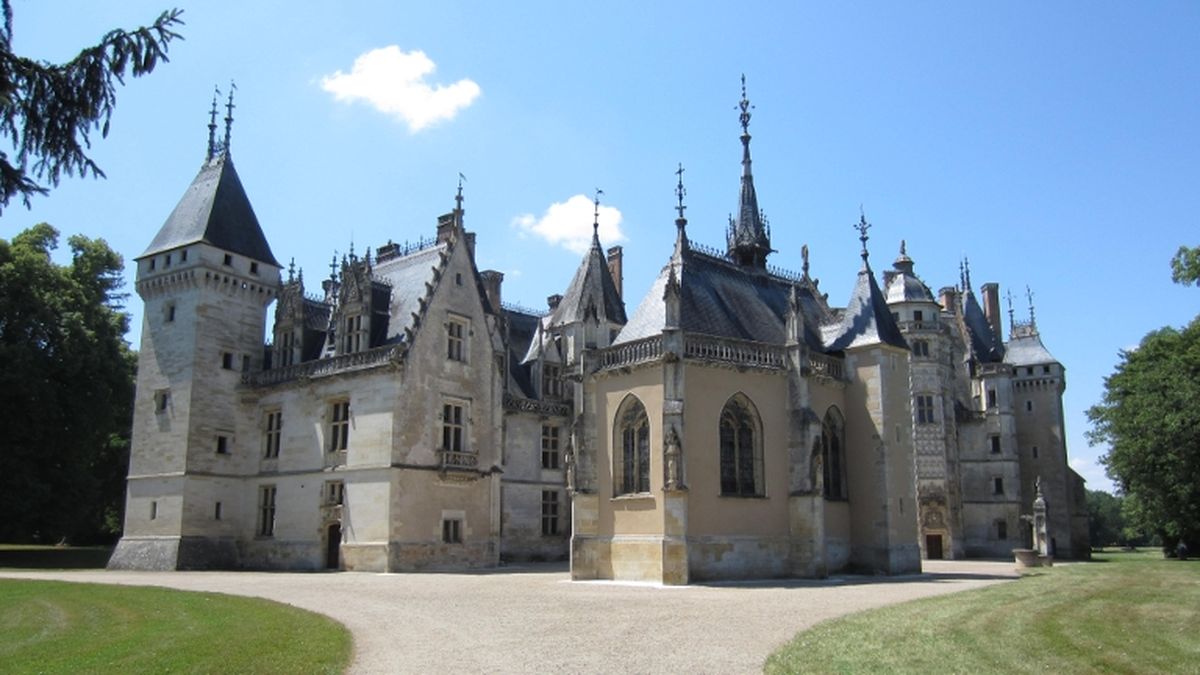 The castle | ©Anecdotrip.com / CC-BY-NC-SA
The castle | ©Anecdotrip.com / CC-BY-NC-SAA Sancerre among the kings
Meillant first belonged to lords of Charenton, who raised a primitive fortress on the location of a Gallo-Roman stronghold. Then, Agnès de Charenton brought the land to her husband Raoul VII, prince of Déols in the 12th century.
And counts of Sancerre turned up… A mighty family! Besides, one of them, Louis, king of Charles VI’s loyal knight and constable of France, was allowed to be buried among kings in basilica of Saint-Denis!
D’Amboise de Chaumont’s buildings
The cardinal site foreman
Meillant then fell to the d’Amboise de Chaumont in 1453, by marriage. Charles I d’Amboise, king Louis XI’s favourite, raised a brand new main building in 1473. When he died, his son Charles II turned up in Meillant, in 1490. But he had better things to do: occupied by the war, he let the building work to his uncle, the famous cardinal Georges d’Amboise...
A stony rebus
To extend the western building raised by Charles I, he built a brand new dwelling house with a gorgeous High Gothic façade, with mullioned windows and a staircase tower named the ″Lion’s tower″. Where did this name come from?
Because we can see a golden lion holding the Chaumont’s blazon at the top! Hey, by the way, did you see that, on the stone? A rebus! It says CHAUD MONT, with a mountain in fire for Chaumont (″hot hill″)!
Meillant and Italy
Milan made Meillant
Charles II became marshal and admiral of France, then lieutenant in Italy. There, he saw the Renaissance architecture and was inspired for Meillant…
And Charles worked in Meillant’s building work with the best Italian artists, including Da Vinci’s friends like Bernardino de Conti or Solari…
Cardinal Bibiena said ″Milan made Meillant″, because the castle was so beautiful. Meillant means ″the middle of the plain″, and it later gives the name of Milan, in Italy!
Damned mud!
Charles was also king Louis XII’s loyal subject. You know what? The king went in 1505 in Meillant, but Charles wasn’t here. His domestics hosted him, but Louis wasn’t happy at all.
He let this letter before leaving: ″I came to see you in your castle, but I get stuck in the mud. You were not here, the devil takes me if I ever come back here!″
Besides, during the visit, you’ll see a chimney with the king’s porcupine...
Completely nuts!
After Charles II’s death in 1511 in Italy (his only son kicked the bucket at battle of Pavia), his wife Catherine de Beaujeu inherited Maillant.
She let the castle to her niece, a lady of la Rochefoucald, then it fell to the Gorge d'Antraigues: one of them, Pierre-François, became completely mad after his wife’s death. He was crippled with debts and had a dissolute life...
Encounter with a philanthropic
Sacrifice my silverware?
Meillant fell to the Béthune, dukes de Charost in the 18th century: descendants of famous minister of king Henri IV, Sully! In 1755, we found Armand-Joseph de Béthune. Oh, you probably didn’t know him.
But this gentleman born in 1738, a military man, always helped the poor and the sick persons: he even founded hospitals, with his own money. In 1758, he gave all his silverware to the French Monnaie of Paris, saying: ″I sacrificed my life for my country, so now I can also sacrifice my silver!″
Colza and sheeps
He was also an agronomist, raised roads, took care of orphans, settled doctors in remote villages, and introduced new growing in the area: rape, tobacco, madder, merino sheep…
Louis XV introduced him to the Court, saying: ″Look at this man, he’s a very simple chap, but he brought life to 3 of my provinces!″
Then, Armand decided to dry the swamps around his castle of Meillant. His goal? To landscape gardens. He also cleaned up other swamps in Central France...
Tears for Armand
People here appreciated what he did, so Armand escaped from the guillotine during French Revolution, thanks to a petition… unlike his son who was executed! Inconsolable, the duke died in Meillant in 1800, buried in the castle’s chapel.
No harm, everything is OK!
So: thanks to Armand’s charity, the castle wasn’t damaged during the Revolution. But in the 19th century it was abandoned… until duchess de Mortemart, Armand’s niece, decided to save the estate. She called architect Louis Normand, who re-raised the left wing.
